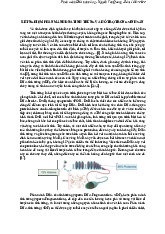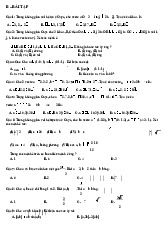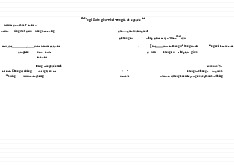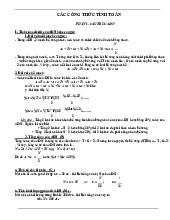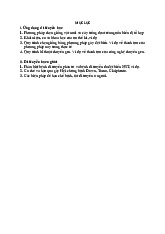








Preview text:
45
Mem Inst Oswaldo Cruz, Rio de Janeiro, Vol. 105(1): 45-51, February 2010
Antimycobacterial neolignans isolated from Aristolochia taliscana
Rosalba León-Díaz1, Mariana Meckes1, Salvador Said-Fernández2, Gloria Maria Molina-Salinas2, Javier
Vargas-Villarreal2, Javier Torres3, Julieta Luna-Herrera4, Adelina Jiménez-Arellanes1/+
1Unidad Investigación Médica en Farmacología de Productos Naturales 3Unidad de Investigación Médica en Enfermedades Infecciosas y
Parasitarias, Hospital de Pediatría, Instituto Mexicano del Seguro Social, Centro Médico Nacional Siglo XXI, Av. Cuauhtémoc 330,
Col. Doctores, CP 06720, Delg. Cuauhtémoc, México DF, México 2División de Biologia Celular y Molecular, Centro de Investigacion
Biomedica del Noroeste, Instituto Mexicano del Seguro Social, Nuevo Leon, México 4Laboratorio de Inmunoquímica II, Departamento de
Inmunoquímica, Escuela Nacional de Ciencias Biológicas, Instituto Politécnico Nacional, México DF, México
Tuberculosis (TB - Mycobacterium tuberculosis) is an ancient infectious disease that has appeared once again as
a serious worldwide health problem and now comprises the second leading cause of death resulting from a single
infection. The prevalence of multidrug resistance (MDR) TB is increasing and therapeutic options for treatment are
not always accessible; in fact, some patients do not respond to the available drugs. Therefore, there is an urgent need
to develop novel anti-TB agents. The aim of the present study was to screen extracts of Aristolochia taliscana, a plant
used in traditional Mexican medicine to treat cough and snake bites, for antimycobacterial activity. The hexanic
extract of A. taliscana was tested by microdilution alamar blue assay against Mycobacterium strains and bioguided
fractionation led to the isolation of the neolignans licarin A, licarin B and eupomatenoid-7, all of which had
antimycobacterial activity. Licarin A was the most active compound, with minimum inhibitory concentrations of 3.12-
12.5 µg/mL against the following M. tuberculosis strains: H37Rv, four mono-resistant H37Rv variants and 12 clinical
MDR isolates, as well as against five non-tuberculous mycobacteria (NTM) strains. In conclusion, licarin A represents
a potentially active anti-TB agent to treat MDR M. tuberculosis and NTM strains.
Key words: antimycobacterial neolignans - A. taliscana - M. tuberculosis H37Rv - MDR M. tuberculosis - non-tuberculous mycobacteria
Medicinal plants are an important natural source of Received 4 June 2009
novel leads in the field of antimycobacterial Accepted 4 August 2009
therapeutics (Cantrell et al. 2001, Copp & Pearce 2007, and approximately 10% of these cases will develop clinical
Gutierrez-Lugo & Bewley 2008). According to manifestations, particularly those patients with
ethnobotanical data, some species of Aristolochia, such compromised immunological systems. The AIDS/HIV
as Aristolochia elegans and Aristolochia grandiflora pandemic has contributed to the worsening of the problem;
have been widely utilized in Mexican traditional in fact, about 30% of registered mortality has been
medicine to treat cough (Diaz 1976). A preliminary associated with TB, especially in developing countries
biological evaluation of the hexanic extract from (Jain & Mondal 2008, Rivers & Mancera 2008). Patients
Aristolochia taliscana Hook roots showed that it with AIDS are also susceptible to becoming infected with
possessed an in vitro antimycobacterial effect against non-tuberculous mycobacteria (NTM) such as M. avium Mycobacterium tuberculosis H37Rv
and (Rodriguez et al. 2006). It is estimated that the worldwide Mycobacterium avium [minimum
inhibitory prevalence of MDR-TB is about 3.2% and that 6.6% of
concentrations (MIC's) = 50 µg/mL]. The plant is these cases are XDR-TB (Rivers & Mancera 2008). The
commonly known in Mexico as guaco or raíz de guaco emergence of XDR-TB strains constitutes a serious health
and neolignans with antiprotozoal activity have already problem because, at present, there is no pharmaceutical
been identified in the species (Enriquez et al. 1984, Abe alternative for treating patients infected with such strains et al. 2002).
(Tomioka 2006, Zager & McNerney 2008). Consequently,
In recent years, the number of patients with novel drugs to treat or prevent the disease are urgently
tuberculosis (TB) has increased rapidly due, in part, to needed (O´Brien & Spigelman 2005, Gutierrez-Lugo &
the appearance of multidrug-resistant (MDR) and Bewley 2008).
extensively drug-resistant (XDR) strains in both
The aim of the present paper was to isolate and
developing and developed countries. One-third of the structurally characterize A. taliscana hexane-extract
world’s population is currently infected with M. compounds that possessed activity against M. tuberculosis tuberculosis
H37Rv, mono-resistant variants of H37Rv, MDR M.
tuberculosis clinical isolates and NTM. MATERIALS AND METHODS
Plant materials - A. taliscana roots were purchased at a
medicinal plant market in city of Mexico, Mexico. The
plant material was compared with the botanical specimen
Financial support: Instituto Mexicano del Seguro Social (FOFOI
deposited at the Herbarium of the Instituto Mexicano del
FP2003-009, 2005/1/I/102), CONACYT (to RLD)
Seguro Social and a voucher was deposited under code
+ Corresponding author: adelinaj@servidor.unam.mx 1106. 46
Antimycobacterial neolignans from A. taliscana • Rosalba León-Díaz et al.
online | memorias.ioc.fiocruz.br
(100→0) to obtain eight tertiary fractions Fa-Fh. The
Extraction and isolation - Powdered air-dried roots (1.5 isolated maroon-coloured powder (80 mg) from Fc-Fe was
kg) were macerated (3 × 48 h) with 12 L of n-hexane. The characterized as eupomatenoid-7 (2) with an m.p. of 100-
extract was filtered and evaporated in vacuo to yield 33 g 104oC (lit. m.p. 105-106°C).
of the crude extract. Open column chromatography (CC)
The secondary fraction FJ (300 mg) was further
was performed employing the silica gel 60 GF254 (70-230 rechromatographed on CC utilizing n-Hex:CHCl3 and
mesh, Merck) as the stationary phase and silica gel 60 F254 CHCl3 as elution systems. Nine 50 mL tertiary fractions
pre-coated aluminium plates (0.2 mm, Merck) for (Fa’-Fi’) were obtained. From Fb’, 196 mg of a white TABLE I
1H-NMR spectral data (δ scale) and coupling constant (J, Hz) for compounds 1-3 isolated from Aristolochia taliscana Proton Compound 1 Compound 2 Compound 3 2 5.09 (J2- - 5.09 3 = 8.97) (J2-3 = 9.5) 3 3.37-3.45 - 3.39-3.47 4 6.72-6.79 J J 7.03 ( 6.77 ( (J 4- 4- 4-6 = 1.5) 6 = 1.5) 6 = 1.5) 6 6.79 6.82 J 6.77 ( 4- (J6-4 = 1.5 ) 6 = 1.5) 2´ 6.92 7.01 6.97 (J2´-5´ = 1.7) (J2´-5´ = 2.0) (J2´-5´ = 1.9) 5´ 6.87 7.25-7.32 6.89 (J5´-6´ = 8.3) (J5´-6´ = 8.2) (J5´-6´ = 8.3) 6´ 6.87 6.98 6.89
(J6´-5´ = 8.3, J2´-6´ = 0-44)
(J5´-6´ = 8.2, J2´-6´ = 0.6)
(J5´-6´ = 8.3, J2´-6´ = 0.44) α 6.35 6.49 6.36 β 6.04-6.15 6.15-6.27 6.04-6.16 γ 1.86 1.90 1.86 CH3 1.37 2.40 1.37 OCH3 3.88 3.97 3.87 OCH3 - 4.03 3.89 OCH2O 5-95 - - OH - 5.75 5.62
all compounds had Jα-β = 15.87 Hz, Jα-γ = 1.7 Hz and Jβ-γ = 6.5 Hz. Compounds 1 and 3 had J3-Me = 6.8 Hz. Record in CDCl3 at 300 MHz.
analytical and preparative thin-layer chromatography product was obtained by crystallization with an m.p. of
(TLC) analysis. Spots were visualized by spraying with a 107-110°C (lit. m.p. 133-134°C), which was identified
10% solution of H2SO4 followed by heating the plates at as licarin A (3). 100°C. Chemical characterization - Chemical
For silica gel CC, the extract (15 g) was fractionated by characterization of the isolated neolignans was and CHCl
eluting with n-Hex: CHCl3(100→0) 3:MeOH
determined by 1H-NMR (Eclipse 300 Jeol, 300 MHz)
(100→0); 72 fractions (250 mL each) were obtained. The
and 13C-NMR (Variant Unity, 300 MHz) using
primary fractions (F1-F15) were combined according to tetramethylsilane as an internal standard in CDCl3.
the results from the TLC analysis. All primary fractions Electron impact-mass spectra were obtained on a Jeol
were tested for antimycobacterial activity.
AX-505 HA mass spectrometer at 70 eV. Infrared (IR)
From the active fraction F5-F7, 975 mg of white spectra on film over NaCl in a Bruker model Tensor 27
needles with a melting point (m.p.) of 82-86oC (lit. m.p. 89-
spectrometer, optical rotation in a Perkin Elmer model
90°C) crystallized. The compound was identified as licarin 345 polarimeter at 25°C using a sodium lamp (589 nm)
B (1) and was also detected in fractions F8-F11. Fractions and m.p. in a Fisher-Johns apparatus. All the
F8-F11 (2.5 g) were re-chromatographed on
spectroscopic data (1H and 13C-NMR) of each
CC using silica gel (75 g) with a solvent gradient of compound were compared with those previously nHex:CHCl
reported in the literature (Enriquez et al. 1984) and are
3 (100→0) and CHCl3:MeOH (100→0). This
process yielded 14 secondary fractions (FA-FN) of 150 mL described in Tables I, II.
each. Secondary fraction FD yielded 40 mg of 1 and
Licarin B (1) - White needles soluble in CHCl3, m.p.
fraction FF (400 mg) was re-chromatographed in CC and 82-86°C, [α] and CHCl
D25°C = -0.262 (MeOH), IR: νmax 2900, 1600
eluted with n-Hex: CHCl3(100→0) 3:MeOH
and 1050-1200. IE-MS: m/z (rel. int.) 324 [M+ (100)],
Mem Inst Oswaldo Cruz, Rio de Janeiro, Vol. 105(1), February 2010 47
309 (12), 293 (8), 278 (28), 202 (6), 135 (20), 121 (8), 91 (7), 77 (14) and 46(5). 48
Antimycobacterial neolignans from A. taliscana • Rosalba León-Díaz et al. TABLE II
alamar blue assay (MABA) test. In addition, the
13C-NMR spectral data for compounds 1-3 in CDCl
following clinical or environmental non-TB 3
isolated from Aristolochia taliscana
mycobacteria isolates were included: Mycobacterium Carbon Compound 1 Compound 2 Compound 3 chelonae, Mycobacterium fortuitum and
Mycobacterium non-chromogenicum. The strains were 2 93.38 151.48 93.77
cultured in Middlebrook 7H9 broth supplemented with 3 45.75 110.19 45.61
10% OADC enrichment (Becton Dickenson, USA) at 3ª
37°C until a logarithmic growth phase was achieved. 133.08 133.05 133.28
M. tuberculosis and non-TB mycobacteria were diluted 4 113.34 109.16 113.32
in 7H9 at the ratios of 1:20 and 1:50, respectively. 5 132.21 133.61 132.20
Bacterial suspensions were fresh when utilized in the 6 109.29 104.42 109.29 assays. 7 144.10 177.82 144.43
Antimycobacterial assay - Extracts, fractions and the 7ª 146.50 142.09 146.58
pure compounds were evaluated by the previously 1’ 134.32 123.67 132.11
described MABA assay (Jimenez-Arellanes et al. 2003, 2’ 106.77 109.43 108.94
2007). Briefly, samples were dissolved in dimethyl 3’ 147.87 146.58 146.66
sulfoxide (DMSO) (20 mg/mL) under sterile conditions. 4’ 147.58 109.43 145.58
Serial two-fold dilutions of each sample (range, 100-3.12 5’ 108.04 114.44 114.07
µg/mL) were prepared to a final volume of 100 µL with 6’
7H9 broth and 100 µL of each mycobacterium suspension 120.18 120.62 119.95
was added to 96-well sterile microplates (Nunc). For M. α 130.91 131.46 130.93
tuberculosis, plates were incubated at 35°C during five β 123.44 124.36 123.45
days, whereas non-TB mycobacteria were incubated for γ 17.87 18.41 18.33
two days. MIC is expressed as the lowest concentration of CH3 (3) 18.33 9.57 17.56
the compound that causes 99% inhibition of OCH
mycobacterium growth. All assays were run in duplicate 3 (7) 55.94 56.05 55.93 OCH
and streptomycin (0.5 µg/mL, Sigma), isoniazid (0.06 3 (3’) - 56.09 55.97
µg/mL, Sigma) and rifampicin (0.1 µg/mL, Sigma) were OCH2 101.06 - -
utilized as positive controls. record in CDCl3 at 300 MHz.
Cytotoxicity assay - The assay was carried out in a
J774A.1 murine macrophage cell line (ATCC HB-197)
using the trypan blue exclusion test. Briefly, purified
Eupomatenoid-7 (2) - Maroon-coloured powder, neolignans were dissolved in DMSO at a concentration of
soluble in CHCl3, m.p. 100-104°C, [α]D25°C = -0.280 20 µg/mL. Cells were grown in 24-well plates using (MeOH), IR: ν
DMEM supplemented with 10% foetal bovine serum
max 3429, 2937, 2849, 1725, 1604, 1513,
1452, 1371, 1267, 1221, 1147 and 1056. IE-MS: m/z (FBS) and antibiotics. Immediately prior to testing,
(rel. int.) 324 (100), 309 (20), 293 (15), 123 (6), 91 (9), monolayers were washed with warm Hanks’ balanced salt 77 (5) and 31 (15).
solution. Serial two-fold dilutions of each compound were
prepared in DMEM supplemented with 10% FBS (1-1/16
Licarin A (3) - White powder, soluble in CHCl3, of MIC against M. tuberculosis H37Rv) and 1 mL/well of
m.p. 107-110°C, [α]D25ºC = -0.15 (MeOH), IR: νmax
each dilution was added. To evaluate cell viability, controls 3541, 2938,
were included in the microplate by adding DMEM media
1673, 1608, 1496, 1269 and 1143. IE-MS: m/z (rel. int.) with DMSO; cell viability was determined after a 24-h
326 (100), 311 (20), 308(7), 295 (5), 202 (10), 123 (8),
incubation period. Trypan blue solution was added and the 91 (10), 77 (8) and 31 (25).
percentage of viable cells was calculated to determine the Mycobacterium strains - The
following cytotoxic index (IC50). The assay was run in triplicate.
mycobacteria from the American Type Culture
Acute toxicity in mice - Male Balb/c mice (22 ± 2.2 g)
Collection (ATCC) were used: M. tuberculosis H37Rv were used to determine the acute toxicity parameter
(27294); mono-resistant strains: H37Rv isoniazid-
following the methodology previously described by Lorke
resistant (35822), H37Rv streptomycin-resistant (1983) and according to the guidelines of the local Ethical
(35820), H37Rv rifampicin-resistant (35838) and Committee for Experimentation in Animals. Animals were
H37Rv ethambutol-resistant (35837); M. avium maintained under standard environmental conditions at 12-
(35717) and Mycobacterium smegmatis (35798). In h light/dark photoperiods with free access to food and
addition, drug-resistant M. tuberculosis clinical isolates water. Mice were randomly divided into five groups of
(12 strains) obtained from Mexican patients with three animals each. Group 1 received the control vehicle
pulmonary disease were also tested. Drug-resistant M. (Tween 20:H2O 2:8), while Groups 2-5 were treated orally
tuberculosis clinical isolates were selected based on with the crude extract at doses of 0.6, 1.0, 1.6 and 2.9 g/kg. their drug susceptibility patterns
against The same design was employed to test the most active
antimycobacterial drugs employing the microdilution primary fraction (F8-F11) and the pure compound (licarin
Mem Inst Oswaldo Cruz, Rio de Janeiro, Vol. 105(1), February 2010 49
A). All samples were solubilized in Tween 20:H2O (2:8)
and were intragastrically administered in a volume that was
less than 10 mL/kg of body weight. Treatment response
was monitored at 1, 2, 4, 6 and 24 h and daily for 14 days,
registering any signal of toxicity. At the end of the
experimental period, the animals were sacrificed in a CO2
chamber to obtain the internal organs (lung, kidney, heart,
spleen and liver) for pathological analysis. RESULTS
Chemical characterization of the isolated neolig- nans
- The three neolignans were characterized by comparing
spectral data (Tables I, II) with those previously reported in
the literature (Enriquez et al. 1984) and the respective
molecular structures of the compounds are illustrated in Fig 1.
Biological evaluation - As shown in Table III, a MIC of Chemical structures of the active neolignans (1-3) from Aristolochia
50 µg/mL was determined for the hexanic crude extract taliscana.
against M. tuberculosis H37Rv and M. avium. Primary
fractionation yielded F8-F11 as the most active fractions, TABLE III
with MIC’s of 12.5-50 µg/mL against M. tuberculosis
Antimycobacterial activity of the hexanic extract and primary
H37Rv strains and 12.5-100 µg/mL against M. avium.
fractions from Aristolochia taliscana
These fractions, as well as F5-F7, were active against all
tested mono-resistant strains of H37Rv and MDR M.
tuberculosis clinical isolates (SIN3, SIN4, MMDO and
Minimum inhibitory concentrations
HG8) and the MIC values obtained ranged from 12.5-50 (µg/mL)
µg/mL (Table IV). In addition, fractions F8-F11 inhibited Mycobacterium Mycobacterium
the growth of NTM as follows: M. non-chromogenicum Sample tuberculosis H37Rv avium
(MIC = 25 µg/mL) and M. smegmatis, M. chelonae and M.
fortuitum (MIC = 50 µg/mL); the fractions were less active Hexanic extract 50 50
against M. avium (MIC = 100 µg/mL). By contrast, F1 ND ND
fractions F5F7 were highly active against M. non-
chromogenicum (MIC = 12.5 µg/mL) (Table V). F2 100 200
Antimycobacterial activity of the pure isolated F3 ND ND
compounds is shown in Table VI. Licarin B (1) was F4
moderately active against H37Rv and against mono- 200 200
resistant variants (MICs, 25-50 µg/mL), but was highly F5-F7 100 200
active against the majority of MDR M. tuberculosis clinical F8 50 100
isolates tested (with MIC values ranging from 12.5-50
µg/mL). Eupomatenoid-7 (2) was active against H37Rv F9 25 100
strains (MIC = 25 µg/mL), the four mono-resistant variants F10 12.5 12.5
of H37Rv and three of the MDR clinical isolates tested F11
(MIC values ranging from 12.5-25 µg/mL). The most 50 50
clinically relevant activity of this compound (MIC = 6.25 F12 200 100
µg/mL) was against an M. tuberculosis clinical isolate F13-F15 200 200
(SIN4) that is resistant to first- and second-line drugs (Table VI). ND: non determined. TABLE IV
Activity of primary fractions against Mycobacterium
tuberculosis H37Rv (reference strain), its four monoresistant
variants and against multidrug-resistant clinical isolates of M. tuberculosis M. tuberculosis MIC (µg/mL) Monoresistant F5-F7 F8- F11 50
Antimycobacterial neolignans from A. taliscana • Rosalba León-Díaz et al. INH-R 25 25 RIF-R 50 25 STR-R 12.5 25 EMB-R 25 25 Clinical isolates SIN3 25 25 SIN4 50 25 MMDO 12.5 25 HG8 25 12.5
EMB-R: ethambutol-resistant of M. tuberculosis H37Rv;
INHR: isoniazid-resistant; MIC: minimum inhibitory concentrations; RIF-R: rifampicin-resistant; STR-R: streptomycin-resistant.
Finally, while licarin A (3) exhibited moderate
activity against M. tuberculosis H37Rv (MIC = 25
µg/mL), this compound was highly active against all
mono-resistant and MDR M. tuberculosis strains tested,
with MIC's ranging from 3.12-12.5 µg/mL (Table VI).
Clinical isolates with highest sensitivity to this
compound included MMDO, HG8 and SIN4. In
addition, licarin A (3) inhibited the NTM M. avium, M.
smegmatis, M. fortuitum (all with MIC = 6.25 µg/mL)
and M. chelonae (MIC = 3.12 µg/mL) (Table V).
Mem Inst Oswaldo Cruz, Rio de Janeiro, Vol. 105(1), February 2010 51 TABLE V
Antimycobacterial effect of the primary fractions and the pure compounds against non-tuberculous Mycobacteria strains MIC (µg/mL) Primary fractions Pure compounds F5-7 Strain F8-11 1 2 3
Mycobacterium non-chromogenicum 12.5 25 12.5 25 ND
Mycobacterium smegmatis > 200 50 > 200 25 6.25
Mycobacterium fortuitum > 200 50 > 200 50 6.25 Mycobacterium chelonae > 200 50 > 200 25 3.12 Mycobacterium avium > 200 100 > 200 50 6.25
MIC: minimum inhibitory concentrations; ND: non determined. TABLE VI
Antimycobacterial activity of the pure compounds from Aristolochia taliscana against Mycobacterium tuberculosis H37Rv and
of the clinical isolates of multidrug-resistant M. tuberculosis MIC of pure compounds Strain (µg/mL )
Drug resistance patterna, b M. tuberculosis 1 2 3 H37Rv
INH, RIF, STR, EMB susceptible 50 25 25 Monoresistant INH-R 25 25 3.12 RIF-R 50 12.5 6.25 STR-R 25 25 3.12 EMB-R 25 25 6.25 Clinical isolates MMDO INH, EMB 12.5 12.5 3.12 MTY650 STR, INH 12.5 50 6.25 MTY663 STR, INH, RIF, EMB, PZA 12.5 50 12.5 MTY675 STR, INH, EMB 12.5 50 12.5 MTY282 STR, INH, EMB, PZA 12.5 50 12.5 HG8 EMB, CLR, ETH 25 25 3.12 SIN3
STR, INH, RIF, EMB, RFB, CLR, ETH 25 25 6.25 MTY234 STR, INH, RIF, PZA 25 50 12.5 MTY112 STR, INH, RIF, EMB 25 50 12.5 MTY559 STR, EMB 25 50 12.5 SIN4
STR, INH, RIF, EMB, RFB, ETH, OFX 50 6.25 3.12 MTY172 INH, PZA 50 50 12.5
a: clinical isolates resistant to: streptomycin (STR), isoniazid (INH), rifampicin (RIF), ethambutol (EMB), rifabutin (RFB),
ethionamide (ETH), clarithromycin (CLR), ofloxacin (OFX), pyrazinamide (PZA); b: resistant pattern was determined by the
microdilution alamar blue assay. MIC: minimum inhibitory concentrations. 52
Antimycobacterial neolignans from A. taliscana • Rosalba León-Díaz et al.
Cytotoxicity assay of the pure neolignans on murine against P-388, KB16 and HT-29 cell lines (Tsai et al. 2001)
macrophage J774A.1 cell line yielded values of IC50 = and this activity for licarin B (100 µM) has been described
6.25 µg/mL for licarin A and B and IC50 = 3.12 µg/mL against the human promyelocytic leukaemia HL-60 cells,
for eupomatenoid-7. The acute toxicity of the crude as it is the compound inactive for caspase-3 activation.
extract, F8-F11 and its most active component, licarin Meanwhile licarin A induces an apoptotic effect by means
A, determined in mice was > 1.706 mg/kg.
of caspase-3 activation (Park et al. 2004). On the other DISCUSSION
hand, Lee et al. (2004) reported that licarin A is a potent
TB is a severe global health problem and the search for inhibitor of phospholipase Cγ1 (PLCγ1) with an IC50 = 15.8
novel therapeutic molecules is a necessity due to the ± 1.3 µM and that it exerts antiproliferative effects against
appearance of resistance to the anti-mycobacterial drugs three human cancer cell lines [A-549 (lung), MCF7
currently in use (Cantrell et al. 2001, O’Brien & Spigelman (breast) and HCT-15 (colon)], suggesting the use of licarin
2005, Tomioka 2006, Gutiérrez-Lugo & Bewley 2008). A as a cancer chemotherapeutic and chemopreventive
Medicinal plants comprise a promising natural source for agent (Lee et al. 2004, Park et al. 2004). The cytotoxicity
the discovery of anti-TB drugs and the in vitro activity of of A. taliscana-isolated neolignans on murine macrophages
several secondary metabolites has already been was IC50 = 3.256.25 µg/mL; these values were similar to
recognized. At present, 12-demethylmulticauline isolated those determined for the MIC parameter.
from Salvia multicaulis (MIC= 0.46 µg/mL), micromolide
The results obtained here permit us to suggest
from Micromelum hirsutum (MIC= 1.5 µg/mL) and (E)-
further biological evaluation of the effect of licarin A
phytol from Leucas volkensii (MIC= 2 µg/mL) are the most against macrophages infected with MDR M.
highly active compounds reported against M. tuberculosis tuberculosis, to determine the compound’s intracellular
H37Rv (Cantrell et al. 2001). Unfortunately, little activity.
information is available concerning the activity of natural
In conclusion, a low-toxicity neolignan was isolated
compounds against MDR M. tuberculosis strains (Newton from the hexane extract of A. taliscana roots,
et al. 2002, Gibbons et al. 2003, Luna-Herrera et al. 2007). structurally identified as licarin A and shown to be the
While the use of Aristolochia species has been most active compound against all mycobacteria tested.
discussed extensively because of its content of aristolochic Licarin A is a new prototype molecule that exerts a
acid (Chen et al. 2007), this toxic compound was not relevant biological effect against the mycobacteria
detected in A. taliscana-root hexane extract. Moreover, the responsible for MDR-TB, a pandemic that is increasing LD
at present and represents a serious health problem
50 for the hexanic extract determined in mice was > 1706
mg/kg. When evaluating this extract against M. worldwide. In vivo experimental studies are in progress
tuberculosis H37Rv and M. avium, moderate in vitro to establish the antiTB potential of this compound.
activity (MIC = 50 µg/mL) was determined. Activity REFERENCES
against M. avium is of interest because currently, there is a Abe F, Nagafuji S, Yamauchi T, Okade H, Maki J, Higo H, Akahane
high frequency of TB cases associated with this species in
H, Aguilar A, Jimenez-Estrada M, Reyes-Chilpa R 2002. HIV/AIDS cases.
Trypanocidal constituents in plants 1. Evaluation of some
Bioguided fractionation of the extract led to the
Mexican plants for their trypanocidal activity and active
isolation of the previously identified neolignans licarin B,
constituents in guaco roots of Aristolochia taliscana. Biol Pharm
eupomatenoid-7 and licarin A (Enriquez et al. 1984, Abe et
Bull 25: 1188-1191.
al. 2002). While several biological effects (antibacterial, Cantrell CL, Franzblau SG, Fischer NH 2001. Antimycobacterial plants
antioxidant, anticancer, trypanocidal, neuroprotective,
terpenoids. Planta Med 67: 685-694.
insecticidal and anti-inflammatory) of these compounds Chen SM, Fan MY, Tseng CC, Ho Y, Hsu KY 2007. Pharmacokinetics
have been reported, to our knowledge, this is the first report
and nephrotoxicity of aristolochic acid in rabbits. Toxicon 50:
on their anti-TB activity (Tsai et al. 2001, Abe et al. 2002, 180-188.
Lee et al. 2004, Ma et al. 2004, 2005, Park et al. 2004, Copp BR, Pearce AN 2007. Natural product growth inhibitors of Saleem et al. 2005).
Mycobacterium tuberculosis. Nat Prod Rep 24: 278-297.
Licarin A (LD50 > 1706 mg/kg) displayed the most
Díaz JL 1976. Usos de las plantas medicinales de México. Monografías
potent effect against all tested mono-resistant strains of
científicas III, 1st ed., IMEPLAM, México, 204 pp.
H37Rv and MDR clinical isolates of M. tuberculosis
(MIC's ranging from 3.12-12.5 µg/mL). Likewise, licarin Enriquez RG, Chavez MA, Reynolds WF 1984. Phytochemical
investigation of plants of the genus Aristolochia. 1. Isolation and
A was active against the non-TB mycobacteria M. avium,
NMR spectral characterization of eupomatenoid derivatives. J
M. chelonae, M. fortuitum and M. smegmatis (MICs
Nat Prod 47: 896-899.
ranging from 3.12-6.25 µg/mL). A drug that is able to
inhibit MDR M. tuberculosis and M. avium growth, such Gibbons S, Fallah F, Wright CW 2003. Cryptolepine hydrochloride: a
potent antimycobacterial alkaloid derived from Cryptolepis
as licarin A, would be of extremely high value in the clinic,
sanguinolenta. Phytother Res 17: 434-436.
particularly in cases of HIV/AIDS and MDR/XDR.
Lignans are well-known secondary metabolites because Gutierrez-Lugo MT, Bewley CA 2008. Natural products, small
molecules and genetics in tuberculosis drug development. J Med
of the cytotoxic effect they produce in several cell lines
Chem 51: 2606-2612.
(Tsai et al. 2001, Park et al. 2004, Kong et al. 2005). The
cytotoxic activity of licarin A has also been reported
Mem Inst Oswaldo Cruz, Rio de Janeiro, Vol. 105(1), February 2010 53
Jain A, Mondal R 2008. Extensively drug-resistant tuberculosis:
current challenges and threats. FEMS Immunol Med Microbiol 53: 145-150.
Jimenez-Arellanes A, Meckes M, Ramirez R, Torres J, Luna-Herrera
J 2003. Activity against multidrug-resistant Mycobacterium
tuberculosis in Mexican plants used to treat respiratory diseases.
Phytother Res 17: 903-908.
Jimenez-Arellanes A, Meckes M, Torres J, Luna-Herrera J 2007.
Antimycobacterial triterpenoids from Lantana hispida (Verbe-
naceae). J Ethnopharmacol 111: 202-205.
Kong ZL, Tzeng SG, Liu YC 2005. Cytotoxic neolignans: an SAR study.
Bioorg Med Chem Lett 15: 163-166.
Lee J, Kim J, Yu Y, Kin Y 2004. Inhibition of phospholipase C gamma
1 and cancer cell proliferation by lignans and flavans from
Machilus thunbergii. Arch Pharm Res 27: 1043-1047.
Lorke D 1983. A new approach to partial acute toxicity testing. Arch
Toxicol 54: 275-287.
Luna-Herrera J, Costa MC, Gonzalez HG, Rodrigues AI, Castilho PC
2007. Synergistic antimycobacterial activities of sesquiterpene
lactones from Laurus spp. J Antimicrob Chemother 59: 548-552.
Ma CJ, Kim SR, Kim J, Kim YC 2005. Meso-dihydroguaiaretic acid
and licarin A of Machilus thunbergii protect against
glutamateinduced toxicity in primary cultures of rat cortical cells.
Br J Pharmacol 146: 752-759.
Ma CJ, Sung SH, Kim YC 2004. Neuroprotective lignans from the
bark of Machilus thunbergii. Planta Med 70: 79-80.
Newton SM, Lau C, Gurcha SS, Besra GS, Wright CW 2002. The
evaluation of forty-three plant species for in vitro
antimycobacterial activities, isolation of active constituents from
Psoralea corylifolia and Sanguinaria canadensis. J
Ethnopharmacol 79: 57-67.
O’Brien R, Spigelman M 2005. New drugs for tuberculosis: current
status and future prospects. Clin Chest Med 60: 327-340.
Park BY, Min BS, Kwon OK, Oh SR, Ahn KS, Kim TJ, Kim DY, Bae K,
Lee HK 2004. Increase of caspase-3 activity by lignans from
Machilus thunbergii in HL-60 cells. Biol Pharm Bull 27: 1305-1307.
Rivers EC, Mancera RL 2008. New anti-tuberculosis drugs with novel
mechanisms of action. Curr Med Chem 15: 1956-1957.
Rodriguez JC, Garcia-Pachon E, Ruiz M, Royo G 2006. Drug
susceptibility of the Mycobacterium genus in vitro test and clinical
implications. Curr Clin Pharmacol 1: 277-279.
Saleem M, Kim HJ, Ali MS, Lee YS 2005. An update on bioactive plant
lignans. Nat Prod Rep 22: 696-616.
Tomioka H 2006. Current status of some antituberculosis drugs and the
development of new antituberculous agents with special reference to
their in vitro and in vivo antimicrobial activities. Curr Pharm Des 12: 4047-4070.
Tsai IL, Chen JH, Duh CY, Chen IS 2001. Cytotoxic neolignans and
butanolides from Machilus obovatifolia. Planta Med 67: 559-561.
Zager EM, McNerney R 2008. Multidrug-resistant tuberculosis. BMC
Infect Dis 8: 10.
